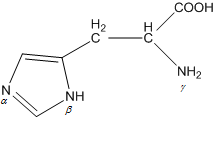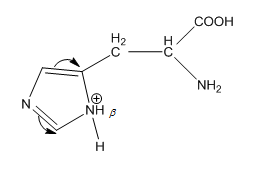
When the imidazole ring of Histidine is protonated, the tendency of nitrogen to be protonated (proton migrates from-COOH) is in the order?

A.
B.
C.
D.

Answer
480.3k+ views
2 likes
Hint: We know that protonation is the process of transfer of transfer of proton
Complete step by step answer:
Here,
In

In

We know that the resonance makes a compound stable.Therefore, protonation occurs before
So, the order of protonation is
So, the correct answer is Option C.
Additional Information:
Protonation is a known fundamental chemical reaction. It is a step of many catalytic and stoichiometric processes. If a molecule or ion can undergo more than one protonation it is termed as polybasic acid. Deprotonation is the reverse of protonation reaction. In deprotonation reaction, a proton is removed from a compound. This reaction occurs in most acid-base reactions. Substances that can protonate another substance are termed as Bronsted Lowry acid.
Note: Always remember that resonance stabilizes a compound. Resonance is the phenomenon as a result of which a molecule can be expressed in different forms, none of which can explain all the properties of the molecule. The actual structure of the molecule is termed a resonance hybrid.
Complete step by step answer:
Here,
In

In

We know that the resonance makes a compound stable.Therefore, protonation occurs before
So, the order of protonation is
So, the correct answer is Option C.
Additional Information:
Protonation is a known fundamental chemical reaction. It is a step of many catalytic and stoichiometric processes. If a molecule or ion can undergo more than one protonation it is termed as polybasic acid. Deprotonation is the reverse of protonation reaction. In deprotonation reaction, a proton is removed from a compound. This reaction occurs in most acid-base reactions. Substances that can protonate another substance are termed as Bronsted Lowry acid.
Note: Always remember that resonance stabilizes a compound. Resonance is the phenomenon as a result of which a molecule can be expressed in different forms, none of which can explain all the properties of the molecule. The actual structure of the molecule is termed a resonance hybrid.
Latest Vedantu courses for you
Grade 6 | CBSE | SCHOOL | English
Vedantu 6 Pro Course (2025-26)
School Full course for CBSE students
₹45,300 per year
Recently Updated Pages
Master Class 9 General Knowledge: Engaging Questions & Answers for Success

Master Class 9 English: Engaging Questions & Answers for Success

Master Class 9 Science: Engaging Questions & Answers for Success

Master Class 9 Social Science: Engaging Questions & Answers for Success

Master Class 9 Maths: Engaging Questions & Answers for Success

Class 9 Question and Answer - Your Ultimate Solutions Guide

Trending doubts
Give 10 examples of unisexual and bisexual flowers

Draw a labelled sketch of the human eye class 12 physics CBSE

Differentiate between homogeneous and heterogeneous class 12 chemistry CBSE

Differentiate between insitu conservation and exsitu class 12 biology CBSE

What are the major means of transport Explain each class 12 social science CBSE

Why is the cell called the structural and functional class 12 biology CBSE




